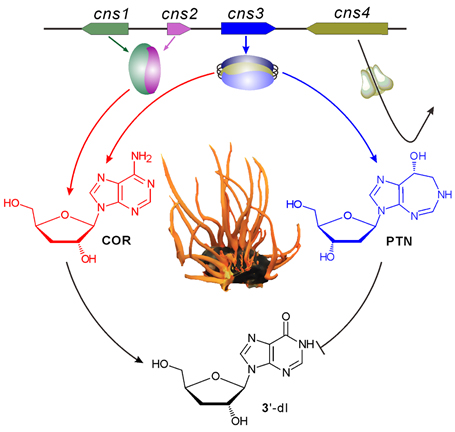Dual Biosynthesis of the Anticancer Compounds Cordycepin and Pentostatin by a Single Gene Cluster in Fungi
Both the adenosine analogs cordycepin (3’-deoxyadenosine) and pentostatin (2’-deoxycoformycin) have anticancer activities. Cordycepin was first identified from the medicinal fungus Cordyceps militaris whereas pentostatin, an irreversible inhibitor of adenosine deaminase (ADA), was first identified from a bacterium. The latter has been developed as a commercial drug to treat hairy cell leukemia.
Prof. WANG Chengshu’s group at the Shanghai Institute of Plant and Physiology and Ecology of Chinese Academy of Sciences previously unveiled the dual biosynthetic mechanism of cordycepin and pentostatin in
C. militaris by following a protector-protégé strategy. The findings have been published in
Cell Chemical Biology on October 19, 2017.
In this study, they found for the first time that C. militaris can also produce pentostatin, and that these two analogs are dually biosynthesized by a single gene cluster in fungi. Cordycepin is produced from adenosine by stepwise phosphorylation, dephosphorylation and reduction catalysis. Dual production of pentostatin can prevent cordycepin deamination, thus a protector-protégé strategy of purine metabolism.
Their study showed that, relative to the growth in liquid fermentation or on artificial rice medium, the fruiting bodies of C. militaris harvested from insect pupae produced the highest levels of cordycepin and pentostatin. For which case, the deaminated cordycepin (3’-deoxyinosine) was detected from the pupae fruiting-body samples, which is implicated as a result of ADA derepression to detoxify cordycepin once it reaches a self-toxic level. Having elucidated the biosynthetic pathway, genetic engineering of the fungus can substantially increase the production of cordycepin and/or pentostatin to facilitate pharmaceutical uses of these nucleoside compounds. Alternatively, the engineered yeast cells could produce these bioactive metabolites.
Based on the genome blast analysis and chromatography verification, further study demonstrated that, except for C. militaris, the genomes of the species such as the caterpillar fungus Ophiocordyceps sinensis and the cicada flower C. cicada do not have the cordycepin/pentostatin biosynthetic gene cluster and these fungi cannot produce both adenosine analogs. Interestingly enough, the divergent mold fungus Aspergillus nidulans contains the highly conserved gene cluster and can produce these two compounds.
These results help advance our understanding of purine metabolic mechanisms, and will also benefit the further exploration of medicinal fungi for health and pharmaceutical uses.
This study was funded by the National Natural Science Foundation of China and the Strategic Priority Research Program of Chinese Academy of Sciences.

Dual biosynthesis of cordycepin (COR) and pentostatin (PTN) is mediated by a single gene cluster in
Cordyceps militaris.
Author contact:
Dr. WANG Chengshu, Principal Investigator
CAS Key Laboratory of Insect Developmental and Evolutionary Biology
Shanghai Institute of Plant Physiology and Ecology
Chinese Academy of Sciences
300 Fenglin Road
Shanghai 200032
Phone: (86) 21- 54924157
Email: cswang@sibs.ac.cn
